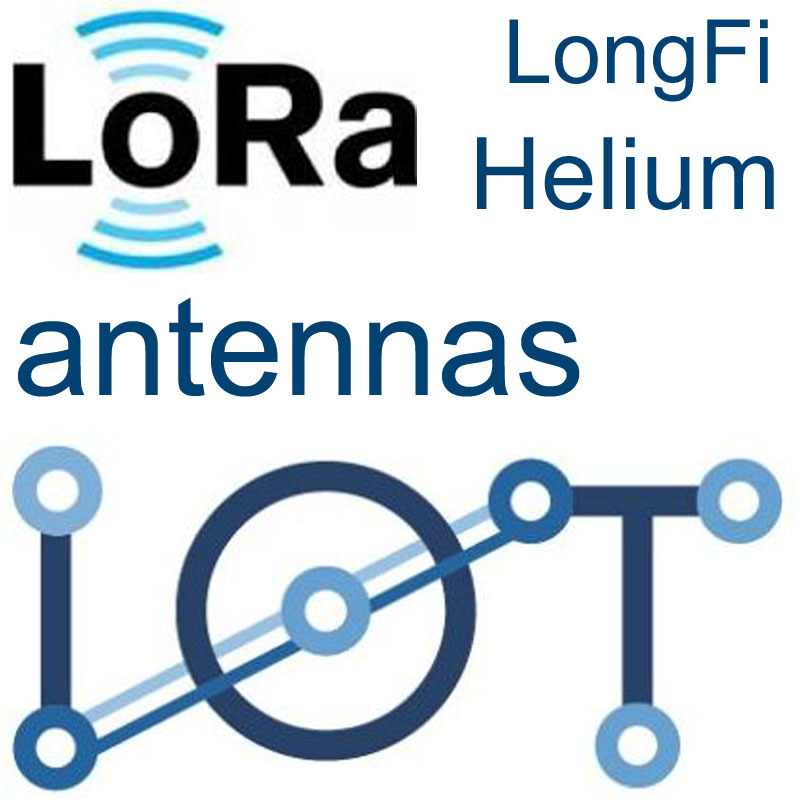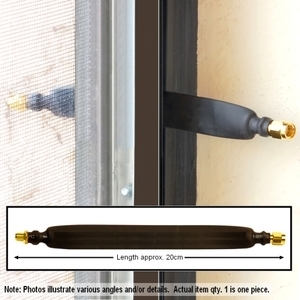Helium Network Gear
Helium Network Gear:
Helium antennas, antenna cables, mounts, weatherproofing accessories: Mount your antenna outdoors for much longer range. Gear to optimize Helium Network Hotspot range:
- Antenna upgrades for Helium Devices:
- Data Alliance's 915 MHz antennas and all of our antenna cables and adapters are compatible with all Helium miners, including Bobcat miners, Sensecap miners and all other Helium LongFi miners.
- North America Helium miners used in North America have an RP-SMA-female antenna connector: Data Alliance's 915 MHz antennas with RP-SMA connectors are all compatible with Helium miners used in North America.
- Europe Helium miners used in Europe have an SMA-female antenna connector: Data Alliance's 915 MHz antennas with SMA connectors are all compatible with Helium miners used in Europe.
- Flat Antenna Cables to pass through window so that you can set your Helium miner outside your window, for much better range.
- All of our Antenna Cables and adapters are compatible with Helium Network routers & gear
- RP-SMA antenna cables & adapters: Compatible with Helium hotspots in Americas
- SMA antenna cables & adapters: Compatible with Helium hotspots in Europe: All of our antenna cables and adapters with SMA-male connectors are compatible with Helium miners used in Europe.
- Mounts: Position your antenna outdoors, in the optimal position, with the hotspot device remaining inside
- Weatherproofing accessories
Antenna Connectors of Helium Miners
| Miner Make & Model | Antenna Connector Type |
| Bobcat Miner 300 | RP-SMA-female |
| RAK Hotspot Miner v2 | RP-SMA-female |
| SenseCAP M1 Helium miner | RP-SMA-female |
| Syncrobit SP Helium HNT miner | RP-SMA-female |
| COTX-X3 Helium Hotspot Miner | SMA-female |
| Kerlink Helium Hotspot Miner | N-female |
| Wirnet iStation | N-female |
| Nebra HNT Indoor Hotspot Miner | RP-SMA-female |
| Nebra HNT Outdoor Hotspot Miner | N-female |
| Syncrobit SP Helium HNT miner | RP-SMA-female |
| Linxdot Helium Hotspot | RP-SMA-female |
| ClodPi Pro Hotspot | RP-SMA-female |
| LongAP Pro IoT Gateway | N-female |
| LongAP Light IoT Gateway | RP-SMA-female |
| VoskCoin Helium Hotspot Miner | RP-SMA-female |
| Dragino LPS8 DLOS8 | SMA-female |
External antennas for Helium Network Miners / Hotspots.
The coverage achieved by a Helium Hotspot is critical to its performance in earning HNT rewards. It is therefore in the interests of Miner owners to achieve the best coverage possible by upgrading the Helium Hotspot antenna to an external antenna with higher gain. The right antenna can pay for itself within days of purchase as it achieves connection to more witness hotspots and the Miner it is connected to will have better PoC performance.
Helium antennas are LoRa antennas, and by using an outdoor LoRa antenna with enhanced performance, Helium users are finding that the Miners can become more profitable which is important given the significant upfront costs. Data Alliance carries LoRa antennas for both the 868 and 915 frequencies.
In areas with a high density of hotspots an outdoor LoRa antenna that is connected to the Miner can produce a significant uplift in earnings. An external omnidirectional LoRa antenna can also have its position adjusted to optimize its range. Fiberglass collinear arrays mounted at height, and magnetic-mount whip LoRa antennas are popular solutions.
A through-window coaxial cable solution is critical for connecting an outdoor LoRa antenna to an indoor Helium Miner/Hotspot.
Outdoor Helium Miners are available, but they are very expensive when compared to indoor Hotspots. The common solution is to run coax from an indoor Miner to a outdoor antenna via a window or door.
Using regular coax will lead to the cable being crushed and damaged. The correct solution for running Helium Hotspot cabling through a window or door is to use a flat coax cable.
Flat Antenna Cables
Flat coaxial cable couplers, also known as window jumpers or window entry cables enable a secure weatherproof connection to be made between an outdoor antenna and indoor radio frequency equipment like a Helium Hotspot. This means that there is no need to drill masonry to bring in antenna Cables from outside, which may not be permitted in rented accommodation.
The flat coaxial coupler has a unique structure that achieves its flattened dimensions. The coupler has within a length of extremely small diameter (mini-coax) coax cable which is insulated supported by copper beads that protect it from the pressure of the closed window or door. Two RP-SMA connectors (male to female RP-SMA connectors) are attached at either end of the flattened length. The coupler has a thickness of 4.5 millimeters (0.18 inches) and has a low signal loss. The flat antenna cable is available in 18 or 30-inch lengths. An adhesive strip on the coupler means that it can be secured to the window or door frame.
Some couplers carry an adhesive strip so that the cable coupler can be fixed to the window frame or a bulkhead connector for secure mounting if required.
- Adapters and accessories for connecting an external LoRa antenna to a Helium Hotspot
- All Helium network antennas, cables, and accessories are RoHS compliant.
Our selection of Helium compatible antennas and equipment are all compliant with the Restriction of Hazardous Substances (RoHS) directive and equivalent domestic and international laws.
The Helium network or Helium is the world's first peer-to-peer wireless network and is supported by LoRa technology.
Helium is also known as The People's Network and has gained prominence for its Low-Power, Long Range, Wide Area Networking delivered via a mesh network of privately deployed hotspots. The participant hotspots or nodes operate as gateways for devices to connect and use the network.
Helium connectivity is primarily used to support Internet of Things (IoT) devices with The People's Network aiming to provide global coverage for IoT.
Because Helium uses LoRa it is a cost-effective and low-energy alternative to cellular or WiFi-based networking.
The Helium Network has been created to facilitate the easy, convenient, and cheap connection of Internet of Things hardware. Networked objects exchange small increments of data and are able to communicate with one another over long distances, hopping from node to node in the mesh network. The hotspots are privately run, sidestepping the availability and cost of cellular networking or WiFi.
The Helium Network operates using the 915 MHz and 868 MHz frequency bands depending on the region where it is being used. Helium is designed to operate on 8 channels within the frequency band.
The mesh network structure of the Helium Network has three key participants:
- End-user devices: These can send and receive encrypted data in line with Heliums proprietary wireless networking protocol, known as WHIP. Devices are typically sensor-based and battery operated and may be used in mobile applications or a remote location.
- Hotspots/Miners: This is the wireless networking equipment that provides the hotspot connectivity that gives Helium its expansive network coverage. They are the backbone of the Helium network. Miners provide a link between end devices and the internet. A single hotspot can support thousands of participating devices, with a coverage area of several square miles, at least 200 times the coverage of WiFi. The Miners are privately owned and can be purchased from Helium by individuals who want to run a hotspot for $400 and upwards. Hotspots are validated through a Proof-of-Coverage (PoC) algorithm. This algorithm verifies the hotspot location and the level of coverage it provides. Verified hotspots are eligible for mining the HNT cryptocurrency. For maintaining continuous Helium coverage that can be accessed and used by devices, hotspot owners are rewarded with payment in cryptocurrency tokens known as HNT. Miners can be installed indoors or outdoors and often use external antennas for boosted coverage and earning potential.
- Routers: Routers are internet applications that acquire data for networked devices from Miners. They are critical to the performance of Helium network applications. In areas of the Helium network where coverage is optimal, routers can use Proof of Location technology, making them able to geolocate devices by using the locations of verified Miners. For Miners to receive their cryptocurrency rewards, routers must also confirm the correct delivery of data from devices.
External LoRa antennas are critical for maximizing the performance and earnings of Helium Miners.
Helium hotspot owners can use outdoor LoRa antennas for enhanced performance of their hotspot. Miners with powerful external antennas are more profitable as they have better coverage and are used more. The boost in earnings is greater in areas with a high density of hotspots.
Outdoor omnidirectional LoRa antennas are sought after for optimizing the range of Miners.











